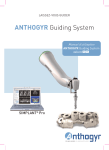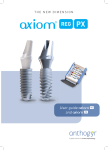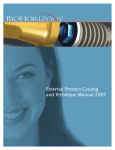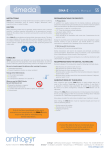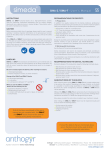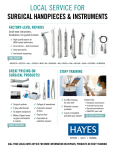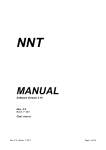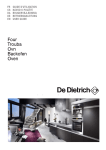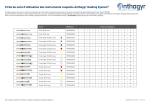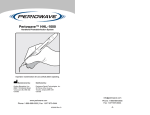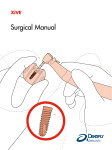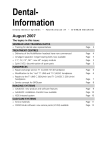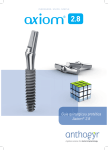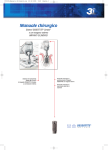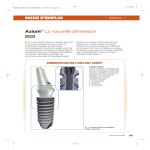Download Anthogyr guiding system user procedures
Transcript
LET US GUIDE YOU ANTHOGYR Guiding System ANTHOGYR Guiding System GE User manual SIMPLANT® Pro 2 Thank you for trusting and choosing to use the ANTHOGYR Guiding System implant solution for GE . For your safety and comfort, our products have been designed exclusively on the basis of data acquired through science and clinical practice. This document, which is specifically for the ANTHOGYR Guiding System for GE, is a complement to the GE manual. It is therefore important to read the information concerning the surgical protocol for the GE implant system beforehand. This document contains the basic information required to use the ANTHOGYR Guiding System for GE with the complete list of components, through surgical protocols specific to the system. The document contains a complete list of components ans few key points for proper use are included as a reminder. The practitioner should received training provided by DENTSPLY (1) for the SIMPLANT® Pro software. Please read the entire GE manual and this document prior to use of the system. Success is mutual. Our business network and our team of experts are entirely at your service to provide any additional information that you might need. The entire Anthogyr team (1) DENTSPLY IMPLANT NV, Technologielaan 15, 3001 Leuven, Belgique, +32 16 39 66 11. Simplant® is a registered trademark of DENTSPLY IMPLANT NV > Scope The ANTHOGYR Guiding System for GE is exclusively intended for guided surgery. It enables the placement of one or more implants with the use of a surgical guide. 3 > Warnings and recommendations These are the detailed instructions for the different phases of the surgical procedure and prosthetic restoration to be followed with the A system. A few general aspects specific to the placement of implants will be reviewed for information purposes only. Under no circumstances is this document on implant and prosthesis-related practice exhaustive and may not give rise to any claim whatsoever. TRAINING : The placement of A components concerns only practitioners who have prior training in implant and prosthetic techniques and who are equipped for these types of procedures. Good knowledge of surgical prosthetic techniques is required for the use of this system. Specific training is provided and delivered at Anthogyr. The A surgical and prosthetic system is intended exclusively for use with the original components and instruments, according to the manufacturer's recommendations. Anthogyr refuses any responsibility for placements that do not conform with this manual, or the use of implants and prosthetic devices and instruments that are foreign to the system. Parts are not interchangeable with other implant systems. Clinical assessment of the patient and the choice of treatment solution are solely the responsibility of the practitioner. The choice of diameter and length of the implant is up to the practitioner's judgement according to the clinical situation. By the same token, the patient should be informed of the potential risks involved in the placement of such a device: oedema, hematoma, hemorrhage, periodontal complications, transitory or permanent nerve damage, local or systemic infections and inflammation, bone fracture, loosening or fracture of the implant, dehiscence, aesthetic issues, inhaling or swallowing the device, iatrogenic trauma, etc. APPARATUS : Practitioners who use the system are responsible for the monitoring and maintenance required to detect and treat complications, and for ensuring proper functioning and safety of the device at an appropriate frequency. The references and batch numbers of all components implanted temporarily or permanently should be noted in the patient's medical record. Monitoring and maintenance are a part of the knowledge that trained practitioners have in the placement of dental implants. It is also the practitioner's responsibility to define the different settings of his equipment (rotational speed, irrigation flow rate, etc.) according to each clinical case, and to ensure that it is in good condition before each procedure. Multiple-use instruments should be cleaned, decontaminated, dried and sterilised prior to every procedure (even with the first use), in conformance with the current protocols in hospitals and clinics. The organisation of the room, the preparation of the operating personnel and the preparation of the patient (pre-medication, anaesthesia, etc.) should be carried out according to the current protocols and under the practitioner's responsibility. Under no circumstances can Anthogyr be held responsible for any damage that might be the result of improper manipulation or use. To avoid swallowing or inhaling small components, it is recommended to secure them outside the mouth with a suture thread. Whenever an instrument is changed, ensure that it is properly secured in the contra-angle or the wrench by applying gentle traction, and that each element is secured on the transport units outside the oral cavity. STORAGE : We pay careful attention to the development of our products and ensure control of the fabrication of all products to be sold. To guarantee their integrity it is recommended to store them in their original packaging at an ambient temperature between 15°C and 30°C away from moisture and direct sunlight. Protect the packaging from dust and do not store in the same room as solvents and/or paint containing solvents or chemical products. The device should be used before the expiration date indicted on the traceability label. In case of damage to the packaging (blister pack with seal cover / pouch) or obvious defect when the product is opened, use of the device is forbidden and the distributor or Anthogyr should be notified of the type of defect and the references and batch numbers of the defective components. The technical specifications in these instructions are provided as an indication and cannot lead to any claim. The A device is not intended to be used on animals. Single-use devices should not be reused, or re-sterilised (risk of contamination and risk of alteration in functional surfaces). The following instructions for use can only be copied or distributed with prior authorisation from Anthogyr. Anthogyr reserves the right to modify the technical features of the products and to provide developments or improvements to the A system without prior notice. The A system is not compatible with the other Anthogyr or competing systems. In case of doubt, the user is responsible for contacting Anthogyr. This publication of the manual cancels and replaces all prior versions . 4 TABLE OF CONTENT 1. Protocols for guided surgery 6 Explanation of the symbols and pictograms 5 A/ THE GUIDED SURGERY APPROACH 6 B/ SURGICAL PROTOCOLS 7 C/ THE GUIDE FIXATION SCREWS 12 D/ MONT BLANC CONTROL® GUIDED SURGERY CONTRA-ANGLE 13 E/ STEP-BY-STEP SURGICAL PROTOCOLS 14 F/ ANTHOGYR Guiding System - GE KIT 24 G/ PROSTHESIS AND SURGICAL PROTOCOL WITH THE FABRICATION OF A 25 TEMPORARY PROSTHESIS PRIOR TO SURGERY H/ CLEANING AND STERILISATION 27 I/ DISMANTLING - ASSEMBLY 27 J/ GE IMPLANT REWORKING 27 2. Component references 27 A/ FIXATION INSTRUMENT AND GUIDE REMOVAL 27 B/ ANTHOGYR Guiding System INSTRUMENTS FOR GE 28 5 Explanation of the symbols and pictograms on the labels S Device sterilised by Gamma Ray O Serial number of the device N Sales reference number of the device B V E F g ù W Y X Z k A Manufacturing date of the device Expiration date of the device Warning: please comply with the instructions for use Non-sterile device Autoclave sterilisation, without packaging Do not sterilise by autoclave Do no reuse. This device is for single use only. Protect from light Do not use if the packaging is damaged Keep dry at a humidity level between 30% and 70% 30°C 15°C G/K Temperature limit between 15°C and 30°C Manufacturer Class I or II medical device in compliance with European directive 93/42/CEE amended by Directive 2007/47/EEC. 6 1. PROTOCOLS FOR GUIDED SURGERY > A. THE GUIDED SURGERY APPROACH In order to use the ANTHOGYR Guiding System device for GE, practitioners should have SIMPLANT® Pro software by DENTSPLY and the patient's computed tomography data. Training in the use of the implant planning software and the ANTHOGYR Guiding System kit for GE is essential. Implant planning that takes advantage of computed tomography (CT or CT-scan) enables practitioners to determine the location of anatomical structures with greater precision. Three types of guides are available: bone support, mucosal support and dental support. They enable the practitioner to place G and C implants at predetermined locations and in the right directions and depths. The result obtained is more secure and predictable and can contribute to immediate prosthetic placement. > Key steps WARNING ! It is essential to read the SIMPLANT® Pro procedure available at www.dentsply.fr Patient examination and treatment evaluation > CT-scans > Importing the computed tomography data in the SIMPLANT® Pro software > Planning the implants and guide fixation screws and then ordering the surgical guide from Dentsply. > Surgery with the surgical guide, the instructions, the guide fixation screws, the GE implant system, the Mont-Blanc Control® for guided surgery and the ANTHOGYR Guiding System kit for GE 7 > B. SURGICAL PROTOCOLS The ANTHOGYR Guiding System for GE provides simple surgical protocols. It ensures rapid and effective familiarisation with the device with perfect control of the implantation. In addition, when combined with the G and C ranges of implants, it enables an exhaustive coverage of treatment indications. The GE implant system provides a comprehensive range of components enabling perfect adaptation to the different needs related to clinical temporisation in implant practice . WARNING ! It is recommended to have an GE surgical kit in the operatory theatre. > B.1 Flap surgery 1 PLACEMENT OF THE SURGICAL GUIDE Tightening the guide fixation screws 6 REMOVAL OF THE SURGICAL GUIDE SURGERY IN 2 STEPS 1. Placement of the cap screw 5-10 N.cm 2 DRILLING Initial drilling Ø2.0 mm 1 500 rpm 3 OPTIONAL: Fixation of the surgical guide Placement of fixation screws on stable implants. 4 DRILLING Drilling sequence 1 000 rpm 5 TAPPING (G) Optional (D1 BONE) 20-25 rpm SCREWING Placement of implants G C 25 rpm 15 rpm IMMEDIATE FUNCTIONING SURGERY IN 1 STEP Placement of an abutment : Placement of the healing cap 5-10 N.cm or or 2. Placement of the healing cap 5-10 N.cm Temporary Standard Multi-Unit Abutment (standard/angulated) 8 > B.2 Flapless surgery 1 PLACEMENT OF THE SURGICAL GUIDE 2 3 CUTTING THE GUM 4 REMOVAL OF THE SURGICAL GUIDE Hold in position manually 7 8 TAPPING Optional (D1 BONE) 20-25 tr/min SCREWING Placement of implants G C 15 rpm 25 rpm SURGERY IN 2 STEPS 1. Placement of the cap screw 5-10 N.cm 6 DRILLING Drilling sequence 1 000 rpm 5 PLACEMENT OF THE SURGICAL GUIDE Tightening the guide fixation screws DRILLING Initial drilling Ø2.0 mm 1 500 rpm 9 OPTIONAL: Fixation of the surgical guide Placement of fixation screws on stable implants REMOVAL OF THE SURGICAL GUIDE IMMEDIATE FUNCTIONING SURGERY IN 1 STEP Placement of an abutment : Placement of the healing cap 5-10 N.cm or or 2. Placement of the healing cap 5-10 N.cm Temporary Standard Multi-Unit Abutment (standard/angulated) 9 > B.3 Range of implants that are compatible with the ANTHOGYR Guiding System for GE G Ø 3.4 MM Ø 4.0 MM 1 Ø 4.6 MM 1 8 mm 10 mm 12 mm 14 mm 1 C Ø 3.4 MM 1 Ø 4.0 MM 1 6,5 mm 6,5 mm 8 mm 8 mm 10 mm 10 mm 12 mm 12 mm 14 mm 14 mm Ø 4.6 MM 1 8 mm 10 mm 12 mm 14 mm 1 6,5 mm 6,5 mm 8 mm 8 mm 10 mm 10 mm 12 mm 12 mm 14 mm 14 mm Color identification code for the implant sizes, repeated on the packaging SINGLE CONNECTION Ø 2.7 Ø 3.4 Ø 4.0 G Ø 4.6 Ø 3.4 Ø 4.0 C Ø 4.6 10 IMPLANT CODING Sales reference Implant code OP : G OP or PX 060 080 dd 100 Implant length lll 120 PX : C 34 140 46 40 Ø implant > B.4 Drilling depths During the planning phase, it is recommended to proceed with a "subcrestal positioning of the implant". This positioning enable better aesthetic management of soft tissues. The surface of the implant ledge is BCP® treated to stimulate peripheral bone healing at this level. When the implant is being selected, take into account over-drilling of 1 mm by the drill tips in addition to the subcrestal positioning of 0.5 mm. Over-drilling provides for the storage of bone chips from the self-tapping of the implant and prevents any apical over-compression. The use of the drill stop and visual depth marks on the different ancillary instruments ensures the preparation of the implant site and the predefined positioning of the implant in conformance with the plan made on the Simplant® Pro software. DRILLING DEPTH = IMPLANT LENGTH + 1mm + SUBCRESTAL POSITIONING (0.5mm) Implant length (mm) Over-drilling of the drill tip Ø4.0 x 10mm 4mm: height of the surgical guide titanium tube 9 mm 0.5 mm Theoretical crestal ridge Subcrestal position (0.5mm) 1 mm 11 > B.5 Drilling sequences E Before the first use and after each procedure, it is essential that all the components are meticulously disinfected, cleaned, decontaminated, dried and sterilised according to the manufacturer's recommendations. Several uses are possible. For good viewing of the laser depth marks, good performance and maximum clinical results, we recommend limiting use to 10 times for all cutting instruments (cutters, drills, reamers, taps, etc.). Drills, cutters, reamers, and taps should be used with external irrigation. > G DRILLING SEQUENCES Forets Ø2.0 Ø2.4 / 3.0 Ø3.0 / 3.6 Ø 3.6 / 4.2 Ø3.4 Ø4.0 Ø4.6 Implants Optional tapping Recommended for D1 bone type Axiom® REG Ø 3.4 mm x x Axiom® REG Ø 4.0 mm x x x Axiom® REG Ø 4.6 mm x x x x Ø2.0 Ø2.4 / 3.0 Ø3.0 / 3.6 Ø 3.6 / 4.2 Axiom® PX Ø 3.4 mm x x Axiom® PX Ø 4.0 mm x x Axiom® PX Ø 4.6 mm x x > C DRILLING SEQUENCES Forets Implants x RECOMMENDATIONS Placement of the C implant is contraindicated in type D1 bone. Do not use the taps when placing C implants 12 > C. THE GUIDE FIXATION SCREWS Anthogyr fixation screws are made of medical grade titanium alloy. The head is 3.5 mm in diameter, the guiding part, 2 mm in diameter and the threaded cone-shaped part, a maximum diameter of 1.6 mm under the head. The screws have a mandrel part enabling direct hold in the contra-angle. Available in 3 lengths: 15, 18 and 21 mm, they are self-drilling, selfbreaking and adaptable on contra-angles. During the planning phase, it is important to place the screw as perpendicularly to the bone as possible. To obtain good stability of the screw plan a 5 mm anchoring in the bone. 1. Self-breaking screw mounted on the mandrel > ACCESSIBILITY Breaking zone The screw is machined in a single block with its grip mandrel which is self-breaking. Mounted directly on the contra-angle, it enables difficult areas to be accessed without the risk of falling in the mouth. Mandrel Length of the threaded part > FLEXIBILITY Screwing can be entirely carried out with the contra-angle or can be completed manually with the screwdriver, ref. INGF004. The torque wrench, ref. INGF005, makes it possible to initiate the breaking of the mandrel. Screw > READY-FOR-USE The screws are delivered sterile and are for single use. 2. Screw head 3. Breaking groove WARNING ! When planning, be sure to take into account the direction of the fixation screw so that placement in the oral cavity is possible. 13 > D. THE MONT BLANC CONTROL® GUIDE SURGERY CONTRA-ANGLE The ANTHOGYR Guiding System for GE has been specifically designed to function with the Mont Blanc Control® contra-angle, equipped with the ANTHOGYR Guiding System drill stop (AX laser mark). The ANTHOGYR Guiding System drill stop has 5 positions that correspond to the 5 heights of the implants that can be used in guided surgery; 6.5, 8, 10, 12 and 14 mm. WARNING ! The use of the drill stop is essential for drilling and reaming. The drill stop should not be used for tapping and screwing the implant: use the visual depth mark that corresponds with the implant. TO ADJUST THE DRILL STOP : > Push the lateral slide bar (A) backwards until the drill stop is released, > Move the drill stop (B) upwards or downwards to the notch adapted to the drilling length. > Release the lateral slide bar (A), > Ensure that the drill stop is secured by applying mild traction. EXAMPLE : On the drawing, the drill stop is set at the "10 mm" mark. This configuration is therefore adapted for the placement of an G or C implant that is 10mm long. WARNING ! Before using the Mont Blanc control®, please read the Mont Blanc control® contra-angle instructions for use. 14 > E. STEP-BY-STEP SURGICAL PROTOCOLS > E.1 Identification of guiding tubes Tubes with various diameters are used with the surgical guide : > Ø4.2 and Ø5.2 tubes to which the ancillary instrument required for preparing the implant site and placing the implant can be fitted. > Ø2.0 tubes can accommodate surgical guide fixation screws and, if necessary, the initial Ø2.0 drill Diameter of the implant Diameter of the gui- Centering ring ding tube Centering wrench Ø 2.0 drills Ø 2.0/2.4 drills Ø 3.4 Ø 4.2 Ø 4.2 Ø 5.2 Ø 5.2 Ø 4.0 Ø 4.6 > E.2 Cutting the tissue (flapless protocol) E Choose the tissue cutter that corresponds with the diameter of the surgical guide tube (see §E.1). Assemble the tissue cutter on the contra-angle and move the contra-angle drill stop to the high position. Visual limit of depth E E Ensure that it is secured on the contra-angle by applying mild traction to the tool. Controlling the stopping depth is done visually with the depth mark on the mandrel. Manually place the guide in position and hold in place Through the guide, progressively move the tissue cutter downwards to the depth mark Rotation speed : 50 rpm Remove the guide and the gum discs Repeat for each gingival cut 15 > E.3 Placement of the surgical guide using fixation screws Fit the fixation screw in the contra-angle. Screw in at 25 rpm until blockage occurs on the guide. In case of a thick bone, drill the cortex with a Ø2.0 drill through the fixation screw guiding tube Drilling at 1,200 rpm with abundant irrigation. The mandrel part breaks automatically when the torque reaches approximately 15 N.cm If the mandrel part of the screw breaks before screwing is completed, finish screwing with the manual screwdriver by inserting the three pins in the notches located on the screw head. If the mandrel does not break when the screw is in place: insert the torque wrench on the screw head and restart the motor until breaking is initiated by torsion. 16 > E.4 Initial drill and green drill Assemble the 2mm or 2.4mm diameter drill (refer to the drilling sequence, § B.5 ) E Ensure that it is secured on the contra-angle by applying mild traction to the tool. Adjust the drill stop to the notch that corresponds with the implant length. E Ensure that the drill stop is secured. Choose the centering wrench that is adapted to the diameter of the drill (see §E.1) Insert the centering wrench in the guide until it blocks Insert the drill in the wrench and then start the drill rotation 17 Drill (at 1,200 rpm) with abundant irrigation in a backand-forth motion until blocking occurs. Stop the drill rotation, then release it from the wrench WARNING ! Drilling should be done with abundant irrigation. It is important to remove the bone shavings after drilling. Do not insert or remove the drill from the centering wrench while it is rotating. >There is a risk of damaging the tip of the drill and/or the centering wrench and/or the guiding tube which could result in blocking > E.5 Red, yellow and white drills ter Choose the centering ring that is adapted to the diameof the guiding tube (see §E.1) and assemble it on the drill. 18 Fit the drill into the contra-angle. Adjust the drill stop to the mark that corresponds with the implant length. Insert the assembly (drill + slide bar) in the guide and then start the drill rotation. Drill at 800 rpm with abundant irrigation in a back-andforth motion until blocking occurs. Stop the drill rotation, then remove the guide assembly (drill + slide bar). WARNING ! Drilling should be done with abundant irrigation. It is important to remove the bone shavings after drilling. Do not insert or remove the drill from the centering ring while it is rotating. >There is a risk of damaging the tip of the drill and/or the centering ring and/or the guiding tube which could result in blocking 19 > E.6 Tapping (Optional and only for G implants ) Choose the centering ring that is adapted to the diameof the guiding tube (see §E.1) and assemble it on the tap. ter Fit the tap in the contra-angle E Raise the contra-angle drill stop to the highest position . Tap at 25 rpm to the visual depth mark corresponding to the length of the implant. Once the mark is reached, remove the guide tap in the "reverse" mode. E It is important not to use the drill stop due to the risk of blockage occurring on the guide and deteriorating the threading made by the tap by its rotation on the spot. 20 > E.7 Transporting the implant into the mouth E Aspirate to remove the bone shavings under the guide at the level of the implant shafts. The presence of bone shavings can compromise the placement of the implant. Fit the mandrel in the contra-angle. E E Raise the drill stop to the highest position. Controlling the stopping depth is done visually using the depth mark on the mandrel. WARNING ! All manipulations are carried out in such a way that direct contact with the external surface of the implant is avoided. Systematically secure the transfer of the implant against the risk of falling in the mouth Pick up the implant directly with the contra-angle. 21 > E.8 Insertion of the implant Set the exit speed of the contra-angle . Screw the implant on the contra-angle in the implant shaft to the visual depth mark on the mandrel Recommended screwing speed : - G : 25 rpm - C : 15 rpm WARNING ! Frequently verify the screwing torque in order not to surpass 80 N.cm. Do not hesitate to loosen and re-screw to reduce tightening strain. It is important not to use the ANTHOGYR Guiding System drill stop due to the risk of blockage occuring on the guide and deteriorating the threading made by the tap by rotation of the implant. It is also possible for the implant to become detached from the mandrel and to continue to advance beyond the intended depth. The indexed connection of the implant authorises 3 possible orientations for prosthetic components, making it possible to reduce the manipulation periods and the risks of confusion during dental restoration. Tri-lobe connection, on the other hand, requires precise anticipated placement of the implant orientation at the end of rotation. WARNING ! The implant orientation phase is decisive. It predefines the final orientation of prosthetic components. After osteointegration and bone maturation, the prosthetic orientation is definitive. It is therefore essential to establish the prosthetic treatment plan prior to surgery, especially when the use of prosthetic components that enable angulation is envisaged. The implant is finally oriented according to the prosthetic solution envisioned and is specific to the component used. 22 > IMPLANT ORIENTATION Screwing mandrels have 3 surfaces, each one with a visual line mark that corresponds with the implant indexing . When screwing or unscrewing the implant, orient as close as possible, one of the marks on the surfaces of the instrument in the appropriate direction, according to the desired prosthetic restoration and the patient’s mouth. The mark that is chosen will define the main prosthetic orientation of the components. ATTENTION ! When orienting the implant, it is important to choose the mark that is closest to the final orientation in order to preserve the apico-coronal positioning . > RECOMMENDATION FOR TRI-LOBE POSITIONING In order to be able to effectively lift the implant axis during the prosthetic phase, the flat surface of the tri-lobe should be placed in the implant emergence axis. > E.9 Optional: fixation screw on a stable implant The fixation screws on an implant make it possible to fix the surgical guide on osteointegrated G or C implants or when stability is considered to be inadequate by the practitioner. Manually screw the fixation screws on the implants, through the guide and without surpassing 15 N.cm. . WARNING ! The user should ensure beforehand that the stability of the implant as a support is adequate. The guide fixation screws are delivered non-sterilised. They should be cleaned, decontaminated and autoclave sterilised prior to use. 23 > E.10 Removal of the surgical guide Unscrew the fixation screws and/or the fixation screws on the implant, and then remove the guide . > E.11 Closing implants Please refer to the GE manual 24 > F. ANTHOGYR Guiding System KIT FOR GE WARNING ! Before the first procedure and after each subsequent procedure, it is imperative to disinfect, clean, decontaminate, dry and sterilise all the instruments and ancillary instruments according to a precise protocol . Emplacements disponibles TECHNICAL SPECIFICATIONS The kit is designed with medical grade materials that enable it to withstand thermal disinfection and autoclave sterilisation. Adjustable protective covers make it possible to change the positioning of the kit in order to optimise the accessibility of the instruments. 25 > G. OPTIONAL: Prosthesis and surgical protocol with the fabrication of a temporary prosthesis prior to surgery Implant analog positioner : The analog positioner enables the fabrication, prior to surgery, of a master model using the surgical guide with mucosal or dental support . This master model can be used to make a temporary prosthesis prior to surgery . > G.1 In the laboratory > Assembling analogs Choose the analog positioner adapted to the diameter of the guiding tubes of the guide (Ø4.2 or Ø 5.2) The visual indexation mark on the analog positioner corresponds with the implant analog indexing The mark that is chosen will therefore define the orientation of the implant and the indexed prosthetic components . > Indexation (Optional) When planning for indexed components, use a small reamer or a surgical marker to mark the guide . > Lubricate the interior of the guide to facilitate unmoulding. Cast the false gum and then the plaster. > Unmould the master model from the surgical guide . > Disassemble the analog positioners and then clean the guide . 26 > G.2 In the operating theater > Screw the implant in the implant shaft to the visual depth mark on the mandrel. When using/planning for indexed components, align one of the marks on the mandrel with the mark on the guide. 27 > H. CLEANING AND STERILISATION Please refer to the GE manual . > I. DISMANTLING - ASSEMBLY Please refer to the GE manual . > J. GE IMPLANT REWORKING Please refer to the GE manual . 2. COMPONENT REFERENCES > A. FIXATION INSTRUMENTS AND GUIDE REMOVAL REFERENCES THE GUIDE FIXATION SCREWS Medical grade titanium Length 15 mm Length 18 mm Length 21 mm OPVGS015 OPVGS018 OPVGS021 FIXATION SCREWS ON A STABLE IMPLANT Medical grade titanium Ø 4.2 mm Ø 5.2 mm OPFG042 OPFG052 SCREWDRIVER Medical grade stainless steel INGF004 FIXATION SCREW MANDREL Medical grade stainless steel Long mandrel Short mandrel INGF001 INGF002 FIXATION SCREW TORQUE WRENCH Medical grade stainless steel INGF005 28 > B. ANTHOGYR Guiding System INSTRUMENTS FOR GE REFERENCES TISSUE CUTTERS Medical grade stainless steel Ø 4.2 mm Ø 5.2 mm OPDG042 OPDG052 INITIAL HELICOIDAL DRILLS Medical grade stainless steel Helicoidal drill Helicoidal drill Ø 2.0 x 21 mm Ø 2.0 x 25 mm OPFES20210 OPFES20250 Medical grade stainless steel Short AGS drill Long AGS drill Ø 2.0/2.4 Ø 2.0/2.4 OPFES24210 OPFES24250 Short AGS drill Long AGS drill Ø 2.4/3.0 Ø 2.4/3.0 OPFES30210 OPFES30250 Short AGS drill Long AGS drill Ø 3.0/3.6 Ø 3.0/3.6 OPFES36210 OPFES36250 Short AGS drill Long AGS drill Ø 3.6/4.2 Ø 3.6/4.2 OPFES42210 OPFES42250 HELICOIDAL STEP DRILLS TAPS (for G only) Medical grade stainless steel Ø 3.4 mm implant tap Ø 3.4 mm implant tap Ø 3.4 x 21 mm Ø 3.4 x 25 mm OPTAS34210 OPTAS34250 Ø 4.0 mm implant tap Ø 4.0 mm implant tap Ø 4.0 x 21 mm Ø 4.0 x 25 mm OPTAS40210 OPTAS40250 Ø 4.6 mm implant tap Ø 4.6 mm implant tap Ø 4.6 x 21 mm Ø 4.6 x 25 mm OPTAS46210 OPTAS46250 WARNING ! The components must be disposed of according to the local directives concerning medical waste. To return components: Anthogyr will refuse any component that might present a risk of infection. Only return components that have been sterilised, with proof of sterility 29 REFERENCES IMPLANT TIGHTENING MANDREL Medical grade stainless steel Ø 4.2 mm Ø 5.2 mm OPMAS042 OPMAS052 CENTERING WRENCH Medical grade stainless steel 4.2/5.2 wrench for Ø 2.0 mm drill 4.2/5.2 wrench for Ø 2.0 / 2.4 mm drill OPCUS001 OPCUS24 CENTERING RINGS Medical grade stainless steel Slide block Slide block Ø 4.2 mm Ø 5.2 mm OPCOS42 OPCOS52 GUIDED SURGERY KIT ANTHOGYR Guiding System for GE Medical grade radel and silicone Full IN MOD OPG2 EVOLUTION KIT Includes the following references : Medical grade stainless steel OPFES24210 OPFES24250 OPMAS042 OPMAS052 OPCUS24 Medical grade radel and silicone 4 inserts KTAGSUP1 MONT BLANC CONTROL® CONTRA-ANGLE FOR GUIDED SURGERY Medical grade stainless steel Complete contra-angle ANTHOGYR Guiding System drill stop 10403X 10418_SAFE IMPLANT ANALOG POSITIONERS Medical grade V titanium Ø 4.2 mm Ø 5.2 mm OPAP042 OPAP052 30 31 063GUIDESYSR-PX_NOT_GB_2015-03 Anthogyr SAS 2 237, Avenue André Lasquin 74700 Sallanches - France Tél. +33 (0)4 50 58 02 37 Fax +33 (0)4 50 93 78 60 www.anthogyr.fr Photo credits: Anthogyr - All rights reserved - Non-contractual pictures Medical devices are intended for use by dentists - Not reimbursed by Social Security - Class IIb - CE0459 Organism notified: LNE/G-MED – Manufacturer: Anthogyr SAS. Please read the instructions in notices and user manuals carefully .
































